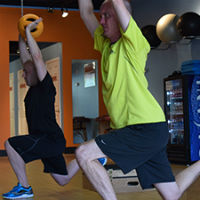Run Strong
To put it simply, runners who strength train are better runners than those who don’t.

You can split runners into two categories: those who run only and those who are well-balanced athletes. Runners who incorporate strength training in their program are typically stronger, healthier, and achieve greater levels of success. Runners who "just run" tend to get injured at a greater rate, therefore, inhibiting their success. Runner-specific strength training allows us to become better, stronger, faster athletes.
Talk about throwing down the gauntlet, eh? As Pepper Brooks would say, "It's a bold strategy, Cotton. Let's see if it pays off."
Why would I throw out such a line-in-the-sand statement? Because it’s been proven that strength training helps runners out tremendously. That, and we runners are a stubborn lot who sometimes need to be hit between the eyes with a 2 x 4 before we pay attention.
Now, let's discuss how getting stronger can help runners become better, faster athletes.
Between 30 and 75 percent (depending on which study you look at) of runners get injured each year. Whether you look at the low estimate or the high, those numbers still represent a greater injury rate than you’ll find in football. So if we’re not getting tackled, why do so many of us get injured?
Remember that we take approximately 1,800 steps per mile, landing with the force of several times our body weight with each step. It’s easy to see how a weak link can get beaten down.
For athletes, position is power. Our bodies require the proper positions biomechanically in order to propel us through a gait cycle efficiently. Losing posture and muscular tension initiates muscular instability. Overuse injuries come from losing good running position. That results in instability in the hips, knees, ankles, and feet. (Show of hands: how many of you have had a hip, knee, ankle, or foot injury?) But the stronger we get, the more resilient our bodies will be to the repetitive impact of running—thus lessening the likelihood of injury.
Speed comes from stride length and stride frequency. To improve either (or both) of these, we need to develop the strength to consistently put our body into biomechanically efficient positions. Running-specific strength training allows us to focus on strengthening the precise muscles and their firing pattern to become faster, more efficient runners. Remember, position is power. By developing the strength to put our bodies in the proper position, we improve power output.
Strength training also helps us develop better muscle recruitment and strength. (File that under, Duh, right?) More strength will allow us to put more energy into the ground with each foot strike. Putting more power into the ground allows us to be faster.
Does that mean we need to hit the gym and crank out reps on the bench press? Not exactly.
Running-specific strength training means turning on muscles that might be weak or inhibited—ensuring we even out muscular imbalances—and developing our core strength. A running-specific strength training program can involve bodyweight exercises and mobility work. What type of exercises we need to focus on is as varied as we are. Each runner has different strengths and talents. While almost every endurance athlete needs to strengthen his or her glutes and hips, there are many ways to reach that end.
The best way to set up a run-centric strength training program is to work with an expert who has experience with endurance athletes. He or she will help diagnose your strengths and weaknesses while creating a program to help you become a stronger, more balanced athlete. Your body will adapt to any kind of resistance, and it doesn’t matter where that resistance comes from (body weight, free weights, TRX, etc.), so make sure you find a coach/trainer/program that fits you and your goals. This is not the time for “flavor of the month” training.
If you’re injury-prone or simply putting in a lot of miles, strength work is a no-brainer. It's time to upgrade from injured runner to a healthy, faster athlete. Strength training not only improves our efficiency, but allows us to put more force into the ground, stay healthy for longer periods of time, and finish races faster than ever before.
 Tim Cary is Fleet Feet's Assistant Training Manager and coach of the Fleet Feet-sponsored Runnababez Elite team. Over his more than two decades of coaching, Tim has coached athletes to three national team championships, five national individual championships, two national records, and numerous All-American and All-State honors. Click here to receive Tim's weekly article via email.
Tim Cary is Fleet Feet's Assistant Training Manager and coach of the Fleet Feet-sponsored Runnababez Elite team. Over his more than two decades of coaching, Tim has coached athletes to three national team championships, five national individual championships, two national records, and numerous All-American and All-State honors. Click here to receive Tim's weekly article via email.
Connect With Us
see the latest from Fleet Feet St. Louis